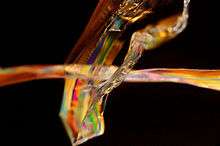John Rosenbaum
John Rosenbaum (September 3, 1934, in Brigantine, New Jersey[1] – September 30, 2003, in Alameda, California), was an American physicist, educator [2] and kinetic sculptor,[3] associated with the San Francisco Renaissance [4][5] and the counterculture of the 1960s.
Biography
John Rosenbaum graduated from Cornell University[6][7] with a degree in engineering physics in 1957.[8] He moved to the San Francisco Bay Area in the early 1960s. He contributed to the Harvard Project Physics textbooks.[9] He was associated with the free school movement in the 1960s, and was a colleague of the educator Herbert Kohl,[10] who described Rosenbaum's educational work in his books The Open Classroom[11][12] and Math, Writing & Games in the Open Classroom.[13] He designed the Xylopipes xylophone children's toy for Creative Playthings.[14] Rosenbaum created "Light Boxes",[15] kinetic sculptures using polarized light and layers of cellophane laminated between pairs of rotating glass disks, producing changing patterns and colors similar to, and on a smaller scale than, light shows projected at rock concerts in the 1960s. He was exhibited by the Landau Gallery[16] in Beverly Hills, among others.[17][18][19][20] He was a colleague of silk screen artist Arthur Okamura. He designed the original logo for Herbie Mann's Embryo Records. He died in Alameda, California of complications from Parkinson's disease in 2003.[21]

Exhibitions
- 1969 Felix Landau Gallery, Los Angeles[16]
- 1975 Walnut Creek, California (with Arthur Okamura)[22][23]
See also

- Photoelasticity, related to the birefringent properties of cellophane, as used in Rosenbaum's kinetic sculptures
References
- ↑ "Cornell Elects Rosenbaum", New York Times, Dec 4, 1954 "John J Rosenbaum Jr of Brigantine N J today was elected captain of Cornell's 1955 varsity crosscountry team"
- ↑ "National Endowment for the Arts Annual Report 1982" (PDF). Retrieved January 17, 2012.
- ↑ "August 8, 1997 "Parkinson's fails to squelch artistry of a former scientist", Ronnie Caplane, ''Jewish Bulletin'', August 8, 1997". Jweekly.com. August 8, 1997. Retrieved January 17, 2012.
- ↑ Art in the San Francisco Bay Area, 1945–1980, Thomas Albright. University Presses of California, Columbia and Princeton, 1985, ISBN 0-520-05518-7 (p. 172)
- ↑
- ↑ "Cornell University Men's Cross Country History webpage". Cornellbigred.com. Retrieved January 17, 2012.
- ↑ [ Displaying Abstract ] (December 4, 1954). ""Cornell Elects Rosenbaum", New York Times, Dec. 4, 1954". Select.nytimes.com. Retrieved January 17, 2012.
- ↑
- ↑ Project Physics: Text Holt, Rinehart and Winston, 1975 edition, ISBN 0-03-089634-7, appendix p. A23
- ↑ ""Black Panther Newspaper", "Center for Open Learning and Teaching" workshop notice, ca. 1973". Negroartist.com. Retrieved January 17, 2012.
- ↑ The Open Classroom: A Practical Guide to a New Way of Teaching, Herbert R. Kohl. New York Review/Vintage Books, 1969, pp. 64–65
- ↑ "''The Open Classroom'' online text, p. 24" (PDF). Retrieved January 17, 2012.
- ↑ Math, Writing and Games in the Open Classroom, Herbert R. Kohl. New York Review/Vintage Books, 1974, ISBN 0-394-70995-0, pp. 134–136
- ↑
- ↑ ""Untitled Kinetic Construction", 1968. Yale University Art Gallery". Ecatalogue.art.yale.edu. Retrieved January 17, 2012.
- 1 2 "John Rosenbaum: kinetic constructions with polarized light: exhibition May 26 – June 21, 1969, Felix Landau Gallery". Worldcat.org. June 21, 1969. Retrieved January 17, 2012.
- ↑ Andrews, Oliver. Electric Art, exhibition catalog. Los Angeles: UCLA Art Department, 1969
- ↑ Ollman, Leah (May 23, 1988). "ART REVIEW : Walbridge Exhibit's Power Weakened by Indulgence". Los Angeles Times.
- ↑ "''The New Yorker'', Jan. 6, 1968, digital edition". Archives.newyorker.com. Retrieved January 17, 2012.
- ↑ "John Rosenbaum: Constructions with polarized light by a physicist-artist;", The New Yorker Jan. 6, 1968, p. 10, E. 84th St. gallery listing
- ↑ "Cornell Alumni Magazine" July/Aug. 2004 V. 107 # 1, Alumni Deaths Archived May 16, 2006, at the Wayback Machine.
- ↑ Thompson, Peter, ed.; "John Rosenbaum and Arthur Okamura", Catalogue, The Civic Arts Gallery, May 21 – June 28, 1975
- ↑ "Arthur Okamura Exhibitions/Bibliography, Braunstein/Quay Gallery website". Bquayartgallery.com. Retrieved January 17, 2012.
External links
- Examples of the optical effects used in "Light Boxes":
- sugar syrup solution placed between 2 linear polarizers, producing 3 primary colors
- multiple examples of color produced from polarized light and clear plastics